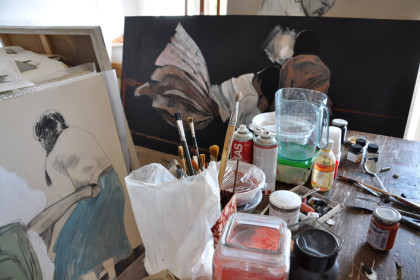
The road along the valley of the river is one of those narrow, shady and cool roads, in the distance the water course begins with clear and calm beaches. A brief – and steep – slope and here it is the house, with the barn still cluttered with furniture and antiques collected by her father, an antiques dealer. Under the trees, two pairs of fierce Chinese lions: ancient, majestic, snow-white in their white marble, are guarding the building in stone that clings to the rocks of the Apennines.
Lucia Conversi has chosen to live in an isolated place, where nature is often a friend and sometimes a threat – earthquake, stray dogs – after studying at the Accademia di Brera, where she found a refuge and a place to paint and draw. The atelier is like her, bright and transparent, hospitable and cozy, full of paintings, finished or work in progress, dominated by a printing woodcuts of artist’s books, and in a corner a disturbing fighting mask brightly colored blends with Risse. This is, in fact, the title of one of the latest series of paintings of Lucia Conversi that, rather than the act itself, the violence of the conflict, is interested in the contrast between well-dressed men, with their tailored suits their ironed shirts, and what happens to the clothes during the awkward and jerky movements of the struggles, she explains us. Tissues are torn, they show unexpected turn and reveal the quarrelsome character that can hide a cared body wearing elegant clothes. “The folds are caves where all the shadows are focused, away from strong light that burns the colors. Areas full of colors and shades, that we are not always proud to show but they exist, and as the less civil part of our push to get out”, writes the artist.
Different, even if the starting point is the same, the discussion on Fighting Cholitas, the Bolivian women who earn pennies lending themtselves to spectacular fights to which often assist their children dressed in bright colored full skirts and petticoats of lace, the color palette chosen by the painter fades in more sober tones, in their attempt to stage an unnatural wickedness, these mighty figures exude a sense of sweetness and mutual solidarity.
But painting to Lucia Conversi is a step taken after a long journey that has its origin in the illustration, and this practice – now high-tech – keeps coming back with interesting projects supported by the publisher Elastico, with whom she made two App illustrating ancient and timeless stories, Pinocchio and Ulysses. Interactive products intended for children but that win first of all the adults, where the hand of the illustrator blends with the technical expertise of the programmer who has provided the tools as well as insights on the creative possibilities of a story rich in detail and “special” effects treated with caution.
 English
English  Italiano
Italiano 














